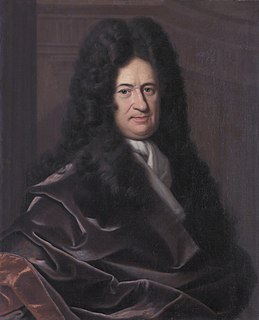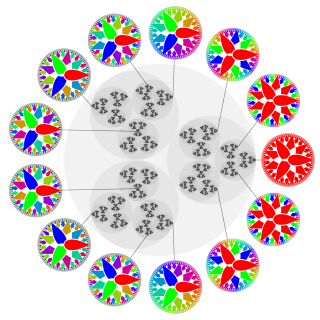In mathematics, a tower of fields is a sequence of field extensions
- F0 ⊆ F1 ⊆ ... ⊆ Fn ⊆ ...
The name comes from such sequences often being written in the form
A tower of fields may be finite or infinite.
In mathematics, a tower of fields is a sequence of field extensions
The name comes from such sequences often being written in the form
A tower of fields may be finite or infinite.
In mathematics, a set is countable if it has the same cardinality as some subset of the set of natural numbers N = {0, 1, 2, 3, ...}. Equivalently, a set S is countable if there exists an injective function f : S → N from S to N; it simply means that every element in S has the correspondence to a different element in N.

In mathematics, computable numbers are the real numbers that can be computed to within any desired precision by a finite, terminating algorithm. They are also known as the recursive numbers, effective numbers or the computable reals or recursive reals.

In mathematics, a field is a set on which addition, subtraction, multiplication, and division are defined and behave as the corresponding operations on rational and real numbers do. A field is thus a fundamental algebraic structure which is widely used in algebra, number theory, and many other areas of mathematics.

The history of calculus is fraught with philosophical debates about the meaning and logical validity of fluxions or infinitesimal numbers. The standard way to resolve these debates is to define the operations of calculus using epsilon–delta procedures rather than infinitesimals. Nonstandard analysis instead reformulates the calculus using a logically rigorous notion of infinitesimal numbers.

In mathematics, a sequence is an enumerated collection of objects in which repetitions are allowed and order matters. Like a set, it contains members. The number of elements is called the length of the sequence. Unlike a set, the same elements can appear multiple times at different positions in a sequence, and unlike a set, the order does matter. Formally, a sequence can be defined as a function from natural numbers to the elements at each position. The notion of a sequence can be generalized to an indexed family, defined as a function from an index set that may not be numbers to another set of elements.

In mathematics, the p-adic number system for any prime number p extends the ordinary arithmetic of the rational numbers in a different way from the extension of the rational number system to the real and complex number systems. The extension is achieved by an alternative interpretation of the concept of "closeness" or absolute value. In particular, two p-adic numbers are considered to be close when their difference is divisible by a high power of p: the higher the power, the closer they are. This property enables p-adic numbers to encode congruence information in a way that turns out to have powerful applications in number theory – including, for example, in the famous proof of Fermat's Last Theorem by Andrew Wiles.
In mathematics, a real number is said to be simply normal in an integer base b if its infinite sequence of digits is distributed uniformly in the sense that each of the b digit values has the same natural density 1/b. A number is said to be normal in base b if, for every positive integer n, all possible strings n digits long have density b−n.

In number theory, the study of Diophantine approximation deals with the approximation of real numbers by rational numbers. It is named after Diophantus of Alexandria.
In mathematics, there are several equivalent ways of defining the real numbers. One of them is that they form a complete ordered field that does not contain any smaller complete ordered field. Such a definition does not prove that such a complete ordered field exists, and the existence proof consists to construct a mathematical structure that satisfies the definition.
In algebraic topology, the Betti numbers are used to distinguish topological spaces based on the connectivity of n-dimensional simplicial complexes. For the most reasonable finite-dimensional spaces, the sequence of Betti numbers is 0 from some point onward, and they are all finite.
In field theory, the primitive element theorem is a result characterizing the finite degree field extensions that can be generated by a single element. Such a generating element is called a primitive element of the field extension, and the extension is called a simple extension in this case. The theorem states that a finite extension is simple if and only if there are only finitely many intermediate fields. An older result, also often called "primitive element theorem", states that every finite separable extension is simple; it can be seen as a consequence of the former theorem. These theorems imply in particular that all algebraic number fields over the rational numbers, and all extensions in which both fields are finite, are simple.
In mathematics, the characteristic of a ring R, often denoted char(R), is defined to be the smallest number of times one must use the ring's multiplicative identity (1) in a sum to get the additive identity (0). If this sum never reaches the additive identity the ring is said to have characteristic zero.
This page lists some examples of vector spaces. See vector space for the definitions of terms used on this page. See also: dimension, basis.
In mathematics, more specifically field theory, the degree of a field extension is a rough measure of the "size" of the field extension. The concept plays an important role in many parts of mathematics, including algebra and number theory — indeed in any area where fields appear prominently.
In mathematics, particularly in the theory of C*-algebras, a uniformly hyperfinite, or UHF, algebra is a C*-algebra that can be written as the closure, in the norm topology, of an increasing union of finite-dimensional full matrix algebras.
Arithmetic dynamics is a field that amalgamates two areas of mathematics, dynamical systems and number theory. Classically, discrete dynamics refers to the study of the iteration of self-maps of the complex plane or real line. Arithmetic dynamics is the study of the number-theoretic properties of integer, rational, p-adic, and/or algebraic points under repeated application of a polynomial or rational function. A fundamental goal is to describe arithmetic properties in terms of underlying geometric structures.

In mathematics, a rational number is a number that can be expressed as the quotient or fraction p/q of two integers, a numerator p and a non-zero denominator q. For example, −3/7 is a rational number, as is every integer. The set of all rational numbers, also referred to as "the rationals", the field of rationals or the field of rational numbers is usually denoted by a boldface Q ; it was thus denoted in 1895 by Giuseppe Peano after quoziente, Italian for "quotient", and first appeared in Bourbaki's Algèbre.

In mathematics, a real number is a value of a continuous quantity that can represent a distance along a line. The adjective real in this context was introduced in the 17th century by René Descartes, who distinguished between real and imaginary roots of polynomials. The real numbers include all the rational numbers, such as the integer −5 and the fraction 4/3, and all the irrational numbers, such as . Included within the irrationals are the real transcendental numbers, such as π (3.14159265...). In addition to measuring distance, real numbers can be used to measure quantities such as time, mass, energy, velocity, and many more. The set of real numbers is denoted using the symbol R or and is sometimes called "the reals".
In mathematics, the Levi-Civita field, named after Tullio Levi-Civita, is a non-Archimedean ordered field; i.e., a system of numbers containing infinite and infinitesimal quantities. Each member can be constructed as a formal series of the form

In mathematics, an algebraic number field is an extension field of the field of rational numbers such that the field extension has finite degree . Thus is a field that contains and has finite dimension when considered as a vector space over .